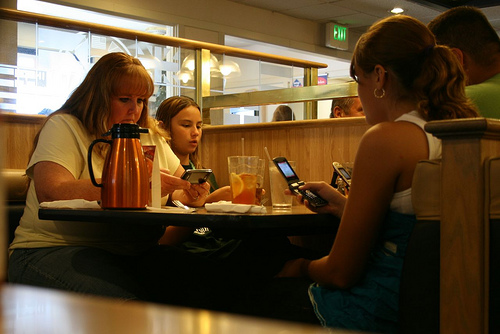 By now, we’ve all probably seen the Gandhi quote, “Be the change you want to see in the world” on a bumper sticker or heard it elsewhere. When it comes to parenting, a slight twist that can work well as a mantra is, “Be the change you want to see in your kids.” Perhaps no where is this more important nowadays than in how we use technology. Technology use…and misuse…presents tremendous challenges to all of us, but it is a particularly maddening problem as parents. It is very difficult to tame the tech beast! But, modeling balanced screen time as parents can be a way to short-circuit this problem.
By now, we’ve all probably seen the Gandhi quote, “Be the change you want to see in the world” on a bumper sticker or heard it elsewhere. When it comes to parenting, a slight twist that can work well as a mantra is, “Be the change you want to see in your kids.” Perhaps no where is this more important nowadays than in how we use technology. Technology use…and misuse…presents tremendous challenges to all of us, but it is a particularly maddening problem as parents. It is very difficult to tame the tech beast! But, modeling balanced screen time as parents can be a way to short-circuit this problem.
Plugged In But Tuned Out
We see our kids hooked on tablets, cell phones, and laptops. Kids hole up in their rooms and will play video games for hours…or binge watch programs on Netflix, Amazon, YouTube, or whatever the latest gadget/format might be. Then there is the irresistible call of social media like Facebook, Twitter, and Instagram. Our kids are instant messaging for the entire time they are doing their homework. Then there is the incessant texting – while walking, driving, at school, and working out. Even when our kids’ best friends are right there with them, we will commonly see groups of teens texting others…presumably not the friends right in front of them! There is a term for this tendency for people to disconnect from in-person social relationships while connecting to others digitally – “alone together.”
As a parent, how many times have you felt frustrated as you tried to get your kid to unplug? I’ve been tempted to make a t-shirt that says something like, “In a minute, Mom – I’m in a level!” I don’t know how many times me and my wife have heard some version of that refrain as our kids were on the iPad or iPhone playing a game. It’s the world in which we all now live.
Is the Pot Calling the Kettle Black?
But one time my hypocrisy struck me smack in the face. My eldest son wanted me to come over and see something, and I was in the middle of a work email…or maybe writing a blog, ahem… on my laptop at home. He was growing increasingly frustrated as he tried to get me to come over. I quipped, “Hold on a minute…um…I’m in a level!” Although I was being cheeky at first, the thought struck me that my son was getting annoyed with me the same way that I often became frustrated at him. kind of like The Cat’s in the Cradle song…DOH!
Be the Change
Here is where the powerful mantra of “be the change you want to see in your kids” is of critical importance. We cannot expect from our kids what we do not demonstrate ourselves. To call back to another pithy maxim, we must practice what we preach. And, to paraphrase more sage wisdom because I just can’t help myself, we should do unto our kids what we would like them to do unto us. Imagine that we were telling our kids that they need to make healthier food choices. “Justin, put down that back of chips and have a banana and some carrot sticks instead!” And we are saying this while we are stuffing our faces with Nacho Cheese Doritos and drinking a Coke. Um, that just doesn’t fly!
We don’t have leverage as parents to tell our kids that they need to rein in their use of technology if we haven’t reined in our own use of technology. As adults, we might be tempted to argue, “Wait – this is important! I’m not playing Clash of Clans or tweeting. This email is for work!” Well, I have news for all of us parents even when our screen time is for work: For kids, the experience of not getting desired or needed attention just because our tech use was work-related still stings. They receive the message, “What I am doing on the computer (or cell phone, tablet) is more important than you.” Ouch! Hey, guess what? That’s one of the main reasons we get so irritated with our kids when they won’t get off their screens – they are choosing whatever is on their screens over us.
The Power of Role Modeling
As parents, we should never underestimate the power of role modeling – for good or for ill. When it comes to having our kids make more responsible and considerate choices regarding their screen time, we must demonstrate that ourselves first. We need to model balanced screen time habits. We must be mindful about setting limits and boundaries around our screen time. We might start by asking ourselves, “How would I like my kid to be setting boundaries around screen time?” For a great clue as to where to set our own boundaries, we should notice when we become annoyed with our kids’ tech use or voice our irritation with them about it. Then we turn our attention back to ourselves and ensure that we are managing our screen time the way we would like our kids to manage it. Our kids will most likely notice how we set these boundaries and will be much more inclined to follow suite than if we were not such boundaries.
In my next blog, I will discuss another way how to use modeling to influence our kids positively if they don’t seem to be noticing all of our efforts.
